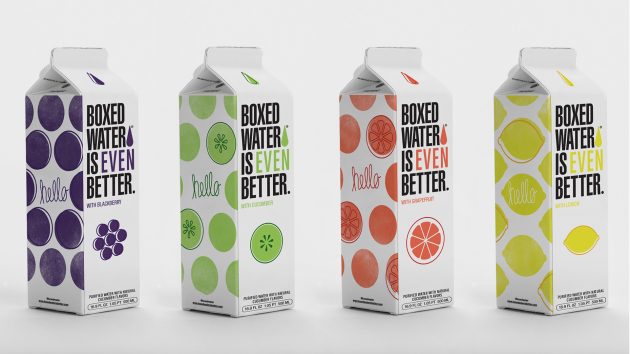
Packaging: Evolution of beverage packaging
By Carol Zweep
Packaging Beverages Editor pick NSF International Photo courtesy Boxed Water Is Better
Photo courtesy Boxed Water Is Better Beverage packaging has evolved over the years. In the 1970s, 2L polyethylene terephthalate (PET) and glass bottles were the predominant package formats for carbonated soft drinks. Since then, the beverage industry has expanded to other categories with different processing techniques. This trend has resulted in various packaging formats and materials to accommodate processing techniques and levels of product protection.
Processing constraints and barrier technology
PET and glass bottles can withstand and retain the internal pressure of carbonated soft drinks. Pasteurization and hot filling for shelf-stable acidic beverages require packaging materials and design considerations for high-temperature filling and vacuum integrity. Retort exposes packages to even higher temperatures, so in addition to choosing appropriate materials, proper package handling systems during processing is critical. Aseptic processing allows for less rigorous packaging constraints for cold filling in paper-based cartons and rigid plastic formats. High-pressure processing is relatively new to the beverage industry, and packages must accommodate high hydrostatic external pressure without compromising package integrity.
Unlike glass and metal, plastics are permeable to gases. Building barrier properties into packaging (bottles, pouches, cartons) can extend product shelf life by preventing product oxidation, which can result in discolouration and off-taste. For bottles, techniques such as inserting a barrier layer within the structure, using an oxygen scavenger in the material, or applying a thin interior or exterior barrier coating are used to mitigate oxidation.
Sustainability and circular economy
The 3Rs (reuse, reduce, recycle) have been the mainstay of sustainability with much effort placed on the reduction or light-weighting of packaging. For example, a 500-ml PET water bottle has decreased from 17 g to as low as 6.5 g (38 per cent of its original weight).
Paper, metal and glass are identified as highly recyclable. Innovation has led to the use of renewable paper-based beverage packaging. Coca-Cola has created a recyclable paper bottle prototype with a paper shell, plastic closure and recycled plastic liner. Boxed Water’s carton and cap are plant-based from well-managed forests. Pulpoloco Sangria from Spain is packaged in a recyclable 250-ml aseptic paper can (CartoCan). The entire can is made from a four-layer paper-based barrier structure except for the pull tab.
Reusable, recyclable or compostable plastic help ensure the material stays within the circular economy. Companies such as Ice River Springs, Evian from Danone and Keurig Dr. Pepper use 100 per cent recycled PET for their beverage bottles. Designing collapsible PET water bottles enables more efficient recycling.
Bacardi has invested in a biodegradable bioplastic technology that uses polyhydroxyalkanoates (PHAs). Unlike conventional plastics made from fossil fuels, micro-organisms produce these polyesters through bacterial fermentation of sugars or lipids.
Several global brands have partnered with Carbios to produce food-grade PET bottles using a novel enzymatic technique. A naturally occurring enzyme found in compost heaps has been optimized to break down any kind of PET into building blocks. This material can be used to make virgin-quality PET. Unlike conventional recycling, enzymatic recycling overcomes degradation issues.
Consumers have shifted their beverage preferences from carbonated soft drinks and fruit juices to energy drinks and functional beverages. Behavioural changes in consumption, advances in processing, technology, and focus on sustainability are all contributing to a shift in beverage packaging. Innovation in materials, packaging design and technologies are paving the way to meeting consumer demands and challenges in the beverage industry.
Carol Zweep is consulting and technical service manager for NSF Canada. Contact her at czweep@nsf.org.
This column was originally published in the April/May 2022 issue of Food in Canada.
Print this page